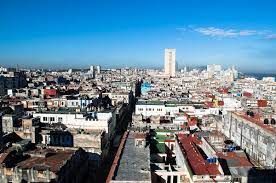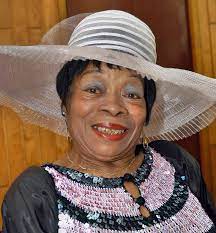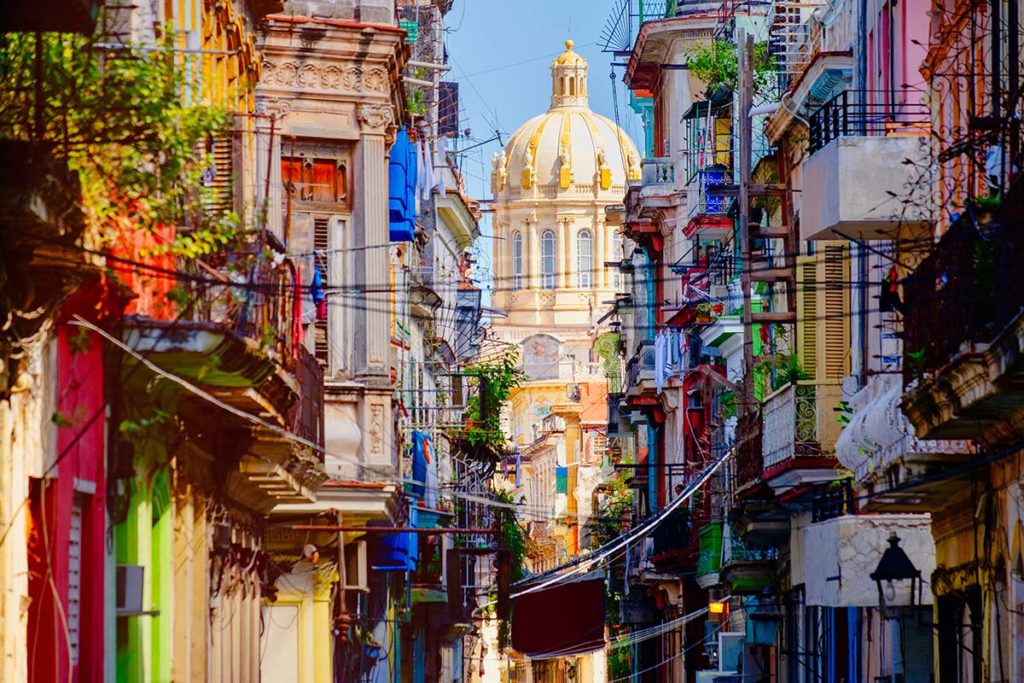JUANA “LA CUBANA” BACALLAO, EXPLOSIVA ‘SHOW WOMAN’, NO CANTA NI BAILA, NO SE LA PIERDAN DE VER!. VIDEOS. PHOTOS.
Neris Amelia Martínez Salazar nació el 26 de mayo de 1925 en el seno de una familia humilde en la populosa barriada de Cayo Hueso, en La Habana. Su padre fue trabajador del muelle. Hija única, quedó huérfana de ambos progenitores a los seis años y fue internada en una escuela de monjas de las Hermanas Oblatas. Desde temprana edad tuvo que luchar y defenderse sola. No estudió música pero toca el piano y las tumbadoras.
Bautizada así por su descubridor, el maestro Obdulio Morales. “La Diosa negra de los cabarets cubanos”. En su modo de interpretar combina letras de canciones con textos burlescos o trágicos, grandilocuente gestualidad y extravagante vestuario. Única en su estilo, ha marcado un hito en la historia del cabaret cubano, desde los 50′ hasta la actualidad.
Neris Amelia Martínez Salazar trabajaba como empleada doméstica al ser descubierta por Obdulio Morales cuando ella limpiaba unas escaleras en la esquina de Laguna y Perseverancia. Al escucharla cantar mientras hacía sus labores como doméstica, se detuvo y le dijo que le quería hacer una prueba para que trabajara en una producción titulada El Milagro de Ochún en el Teatro Martí, donde triunfaron otros grandes como Rita Montaner, Garrido y Piñeiro, Candita Quintana, Alicia Rico y allí entre todas aquellas estrellas de aquel momento, apareció o nació Juana Bacallao.
Obdulio Morales, había creado la guaracha ‘Yo soy Juana Bacallao’ para Neris Amelia Martínez Salazar, la cual en un principio no le agradó, pero gustó mucho cuando la estrenó en el teatro Martí. Nadie como ella ha cantado con tanta gracia y enjundia nacionales aquellas estrofas de:
Yo soy Juana Bacallao
Yo soy Juanita Bacallao
La negra que en el bembé
Salpica pa no mojar
VIDEOS- Juana Bacallao y su Show….
Antes del 59 y despues de este año, la televisión estaba vedada para ella. Confinada a centros nocturnos de segunda o tercera categorías en la playa de Marianao, Centro Habana o Habana Vieja, hacía lo suyo frente a públicos hostiles que le fueron creando una manera muy peculiar de enfrentar al respetable en la que el desenfado se convirtió en su más eficiente arma de batalla. Sus apariciones teatrales provocaban una verdadera guerra con la gente del gallinero y sus incursiones en las fiestas carnavalescas de provincia eran siempre un suceso que se agradecía de buena gana. Después del 59 durante muchos años los estudios de televisión tampoco la recibieron: se le consideraba representante de una sub cultura, vulgar, chabacana, inapropiada.
Desde inicios de los 60 del pasado siglo Juana salió del armario que le conformaban los clubes de poca monta y fue llevada al Hotel Capri a centralizar una muy exitosa revista. Fue la época en que se descubrieron algunos fenómenos de impacto: las cantantes Freddy y La Lupe que alcanzaron una difusión a la que Juana nunca tuvo acceso.
Continuó actuando en los centros nocturnos, moviéndose por provincias, animando fiestas de carnaval, pero lejos, muy lejos, de los órganos de difusión: nada de televisión, ni de radio, ni de discos, ni de grandes teatros. Sin embargo, Juana Bacallao era conocida, popular, admirada y querida. ¿Cómo logró? Pues con un sentido del marketing único y muy personal.
COMO ES JUANA “LA CUBANA” BACALLAO?…
En los tiempos en que nadie imaginaba que alguna vez se inventarían los celulares ella llevaba siempre en la cartera el auricular de un teléfono convencional. En cuanto llegaba a un lugar donde se reunía un grupo considerable de personas, abría la cartera, sacaba el auricular y comenzaba a hablar y a dar órdenes diversas: Ténganme lista la comida que ya voy para allá… Díganle al peluquero que me espere… No encuentro la dirección ¿me la puedes repetir? etc., etc., etc.… A la hora de cruzar la calle Juana esperaba disciplinadamente el cambio de la luz. En cuanto ponían la luz roja emprendía el cruce, el rostro vuelto hacia los autos que se habían detenido, una sonrisa en los labios y… ¡Gracias! ¡Muy amables! ¡Gracias! como si todos se hubieran detenido para que ella pasara. En la noche, cuando se encontraba con alguien que le decía que hacía mucho tiempo no la veía, ella contestaba a toda voz: Yo no salgo de día, porque las estrellas solo salimos de noche.
El vestuario siempre fue el más llamativo y estrambótico que uno pudiera imaginarse, aunque para ser justos hay que decir que siempre vistió ropa de calidad. Sus pelucas, sus empinados tacones, sus largos pendientes, los botines plateados recorrieron con ella las más céntricas calles de La Habana. Y fue así como Juana Bacallao se convirtió en un personaje citadino muy popular.
Pero las batallas siempre acarrean adversidades. Y a ella le tocó la suya.
Vivió una época oscura y triste: el alcohol le impuso una dependencia lastimera. Por esos tiempos no siempre estaba tan acicalada como de costumbre. Recorría las principales calles del Vedado en un estado lamentable. Hasta que un buen día despareció y otro, mucho mejor, reapareció totalmente curada de un mal en el que nunca más ha sucumbido. Recuperó su fuerza, regresó a su entorno vital, emprendió esas noches de trabajo duro frente al público del cabaret, el más agradecido y el más implacable. Se erigió, con valentía, sobre el tiempo malgastado. Volvió a ser ella y mucho más.
ACTUACIONES DE JUANA BACALLAO…
Trabajó en el Hotel Capri en un espectáculo que se llamaba ‘La Serenata’, con Meme Solís, Moraima Secada y Celeste Mendoza, y en otra producción de un gran éxito ‘La Caperucita se divierte’. Otras actuaciones de Juana fueron en el Teatro Campoamor, Los Aires Libres de Prado, los cabarets Sans Sousi, Tropicana, Copa Room del Riviera, Parisien del Hotel Nacional de Cuba, Salón Rojo del Capri, Caribe del Hotel Habana Libre, el Bar Alí y Palermo.
Juana Bacallao ha sido aplaudida en escenarios importantes, pero ella siempre desea volver a sus escenarios, a los cubanos, donde se convirtió en la figura que es hoy en día.
A lo largo de su carrera se presentó junto a personalidades de la talla de Nat King Cole, Bola de Nieve, Celeste Mendoza, Ninon Sevilla, Cantinflas, Rosita Fornés, Omara Portuondo, Rafaela Carrá, Benny Moré, Chano Pozo y Elena Burque.
Conoció Estados Unidos, Francia, México, Venezuela, República Dominicana y España.
En París, Juana Bacallao apareció en la Opéra-Comique en tres ocasiones, cada una de ellas fue un éxito rotundo.
En 2005 se presentó Juana con su agrupación ‘Tiembla Tierra’ en la Ciudad de México con un espectáculo titulado Tiembla Tierra, dirigido por Armando Guerra Sarduy, donde compartió la escena con el conocido intérprete Nelson Ned.
Aún hoy 2016, la podemos encontrar presentando su show en el Club Gato Tuerto junto a jóvenes figuras como Osdalgia Lesmes.
SUS LUCHAS Y TRIUNFOS…
Ha afrontado una carrera larga, muy larga, en la que no han faltado escollos, incomprensiones, discriminación y desdén.
Desde que estrenó la guaracha compuesta por Obdulio Morales, perdió su nombre de pila para convertirse en Juana Bacallao. Y no importa si fue a ella o no, a quien le compusieron la canción, si la conocen o la admiran o es una invención suya o de cualquier otra persona. Pero a estas alturas de su larga vida ya ha dejado de ser hace mucho tiempo Amelia Martínez, como irá dejando de ser Juana Bacallao… para pasar a la posteridad, en la imaginación y la realidad como lo que siempre ha sido. Así, sencillamente: Juana… la cubana.
Pero el mayor enigma sigue siendo que Juana Bacallao ni canta, ni baila, ni se ha podido aprender jamás un guión musical de cabaret. Las espontáneas ocurrencias y los gestos corporales caracterizan a esta show woman. El timbre de su voz es áspero, nada melodioso ni muy agradable al oído. Siempre hace en el escenario lo que le viene en ganas, canta como le parece, desafina bárbaramente, olvida o cambia la letra de las canciones, sin artificios. Es que Juana siempre ha sido un caso raro y único en la historia del arte vernáculo cubano, todo un espectáculo fuera de lo común, extravagante. En la escena se transforma en un ser explosivo y fulminante, sobre todo por su vocabulario de pura candela y gracia popular, llegando a ser hasta en ocasiones vulgar.
PREMIOS Y RECONOCIMIENTO…
En su larga carrera obtuvo diversos premios y reconocimientos.
Distinción por la Cultura Nacional.
Medalla “Alejo Carpentier”
Disco de Oro en Canadá
Premio Nacional del Humor 2020
Sin lugar a dudas, Juana Bacallao es un fenómeno de esos que encierra el misterio de la propia vida, Juana es auténtica, plenamente realizada, sin frustraciones, honesta consigo mismo y con los demás, es por encima de todo, simple y sencillamente eso, ¡Cubanísima!
JUANA “LA CUBANA” BACALLAO, EXPLOSIVE ‘SHOW WOMAN’, DOESN’T SING OR DANCE, DON’T MISS SEEING HER! PHOTOS.
Neris Amelia Martínez Salazar was born on May 26, 1925, into a humble family in the populous neighborhood of Cayo Hueso, in Havana. Her father was a dock worker. She was the only child, she was orphaned by both parents at the age of six and she was admitted to a school for nuns run by the Oblate Sisters. From an early age, she had to fight and defend herself. She did not study music but she plays the piano and the tumbadoras.
She was named after her discoverer, the teacher Obdulio Morales. “The black Goddess of Cuban cabarets”. In her way of interpreting, she combines song lyrics with burlesque or tragic texts, bombastic gestures, and extravagant costumes. Unique in her style, she has marked a milestone in the history of Cuban cabaret, from the 50s to the present.
Neris Amelia Martínez Salazar worked as a maid when she was discovered by Obdulio Morales when she was cleaning some stairs on the corner of Laguna and Perseverancia. Hearing her sing while doing her housework, he stopped and told her that he wanted to audition her to work in a production entitled El Milagro de Ochún at the Teatro Martí, where other greats such as Rita Montaner, Garrido, and Piñeiro, Candita, triumphed. Quintana, Alicia Rico, and there among all those stars of that moment, Juana Bacallao appeared or was born.
Obdulio Morales had created the guaracha ‘Yo soy Juana Bacallao’ for Neris Amelia Martínez Salazar, which he did not like at first, but he really liked it when he premiered it at the Martí theater. No one like her has sung with such grace and national substance those verses of:
I am Juana Bacallao
I am Juanita Bacallao
The black that is in the bembé
Splashes are not to wet
Before ’59 and after this year, television was off-limits to her. Confined to second or third-category nightclubs on Marianao beach, Havana Center, or Old Havana, she did her thing in front of hostile audiences that created a very peculiar way of facing the respectable in which self-assurance became her most efficient battle weapon. Her theatrical appearances provoked a real war with the people of the chicken coop and her incursions into the provincial carnival parties were always an event that she was willingly grateful for. After 1959, for many years, television studios did not receive her either: she was considered the representative of a vulgar, tacky, inappropriate subculture.
Since the beginning of the 60s of the last century, Juana came out of the closet that small-time clubs made up for her and she was taken to the Hotel Capri to centralize a very successful magazine. It was the time when some phenomena of impact were discovered: the singers Freddy and La Lupe who reached a diffusion that Juana never had access to.
She continued to perform in nightclubs, moving around the provinces, animating carnival parties, but far, far away from the media: no television, no radio, no records, no big theaters. However, Juana Bacallao was known, popular, admired, and loved. How did she manage? Well, with a unique and very personal sense of marketing.
WHAT IS JUANA “LA CUBANA” BACALLAO LIKE?…
In the days when no one imagined that cell phones would ever be invented, she always carried the receiver of the conventional telephone in her purse. As soon as he arrived at a place where a considerable group of people gathered, he opened his wallet, took out the receiver, and began to speak and give various orders: Have my food ready, I’m on my way… Tell the hairdresser to wait for me… I can’t find Can you repeat the address? etc., etc., etc… When it was time to cross the street, Juana waited disciplined for the light to change. As soon as they turned on the red light, she began to cross it, her face turned towards the cars that had stopped, a smile on her lips and… Thank you! Very kind! Thank you! as if everyone had stopped for her to pass. At night, when she met someone who told her that she hadn’t seen her in a long time, she answered in a loud voice: I don’t go out during the day, because the stars only go out at night.
Her wardrobe was always the most striking and outlandish one could imagine, although to be fair it must be said that she always wore quality clothes. Her wigs, her steep heels, her long earrings, and her silver ankle boots walked with her through the most central streets of Havana. And that was how Juana Bacallao became a very popular city character.
But battles always bring adversity. And she got hers.
She lived through a dark and sad time: alcohol imposed a pitiful dependency on her. In those days she was not always as groomed as she usually was. She walked the main streets of Vedado in a lamentable state. She until one good day disappeared and another, much better, reappeared totally cured of a disease to which she has never succumbed. She recovered her strength, returned to her vital environment, and undertook those nights of hard work in front of the cabaret audience, the most grateful and the most implacable. She stood, bravely, on wasted time. She was her again and much more.
PERFORMANCES BY JUANA BACALLAO…
She worked at the Hotel Capri in a show called ‘La Serenata’, with Meme Solís, Moraima Secada, and Celeste Mendoza, and in another highly successful production ‘La Caperucita se diverter. Juana’s other performances were at the Campoamor Theater, Los Aires Libres in Prado, the Sans Sousi, Tropicana, Copa Room del Riviera cabarets, Parisien at the Hotel Nacional de Cuba, Salón Rojo del Capri, Caribe at the Hotel Habana Libre, Bar Ali and Palermo.
Juana Bacallao has been applauded on important stages, but she always wants to return to her stage, to the Cubans, where she became the figure she is today.
Throughout her career, she has performed alongside personalities such as Nat King Cole, Bola de Nieve, Celeste Mendoza, Ninon Sevilla, Cantinflas, Rosita Fornés, Omara Portuondo, Rafaela Carrá, Benny Moré, Chano Pozo and Elena Burque.
She visited the United States, France, Mexico, Venezuela, the Dominican Republic, and Spain.
In Paris, Juana Bacallao appeared at the Opéra-Comique three times, each time a resounding success.
In 2005 Juana appeared with her group Tiembla Tierra’ in Mexico City with a show titled Tiembla Tierra, directed by Armando Guerra Sarduy, where she shared the stage with the well-known performer Nelson Ned.
Even today in 2016, we can find her presenting her show at the Gato Tuerto Club together with young figures like Osdalgia Lesmes.
HER STRUGGLES AND TRIUMPHS…
She has faced a long, very long career, in which there have been plenty of pitfalls, misunderstandings, discrimination and disdain.
Since she premiered the guaracha composed by Obdulio Morales, she lost her first name to become Juana Bacallao. And it doesn’t matter if it was her or not, for whom the song was composed if she is known or admired, or if it is her invention or someone else’s. But at this point in her long life, she has long ceased to be Amelia Martínez, as she will cease to be Juana Bacallao… to go down to posterity, in imagination and reality as what she has always been. Like this, simply: Juana… the Cuban.
But the biggest enigma remains that Juana Bacallao neither sings nor dances, nor has she ever been able to learn a cabaret musical script. The spontaneous occurrences and body gestures characterize this show woman. The timbre of her voice is harsh, not melodious, and not very pleasant to the ear. She always does what she wants on stage, she sings as she sees fit, wildly out of tune, and forgets or changes the lyrics of the songs, without artifice. It’s just that Juana has always been a rare and unique case in the history of Cuban vernacular art, quite an unusual, extravagant show. In the scene, she becomes an explosive and withering being, especially due to her vocabulary of pure fire and popular grace, sometimes even being vulgar.
AWARDS AND RECOGNITION…
In her long career, she has obtained various awards and recognitions.
Distinction for National Culture.
Medal “Alejo Carpentier”
Gold Record in Canada
National Humor Award 2020
Without a doubt, Juana Bacallao is one of those phenomena that contains the mystery of her own life, Juana is authentic, fully realized, without frustration, honest with herself and with others, she is above all else, simply and simply that, Very Cuban!
Agencies/ Wiki/ Ecured/ JuanaBacallaoBio./ Extractos/ Excerpts/ Internet Photos/ Arnoldo Varona/ www.TheCubanHistory.com
THE CUBAN HISTORY, HOLLYWOOD.











